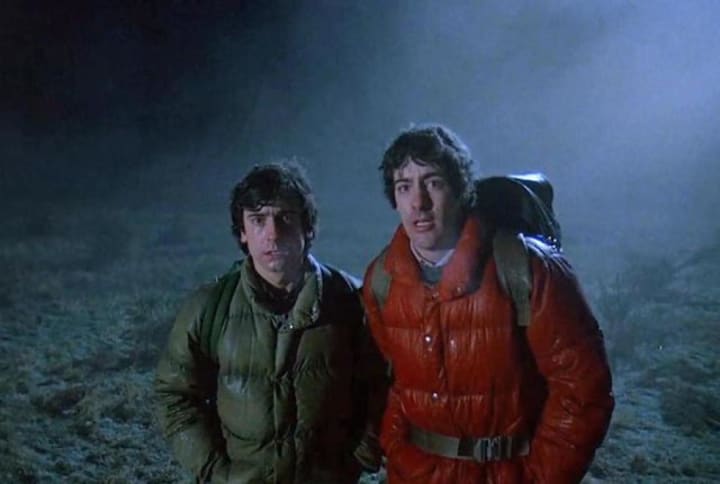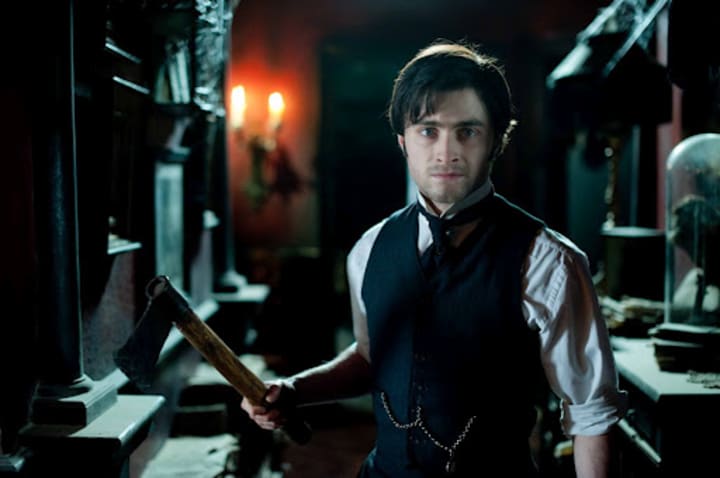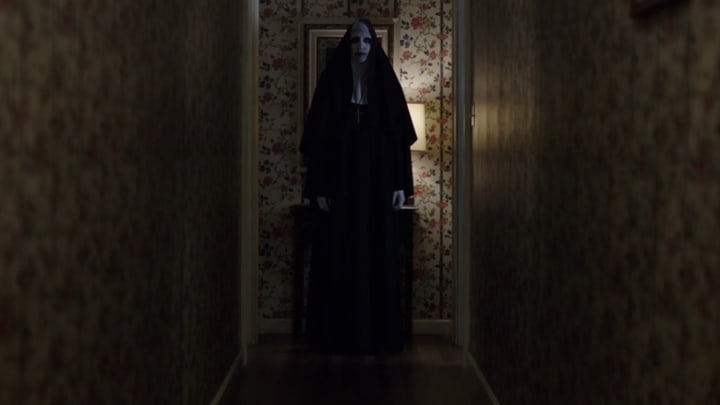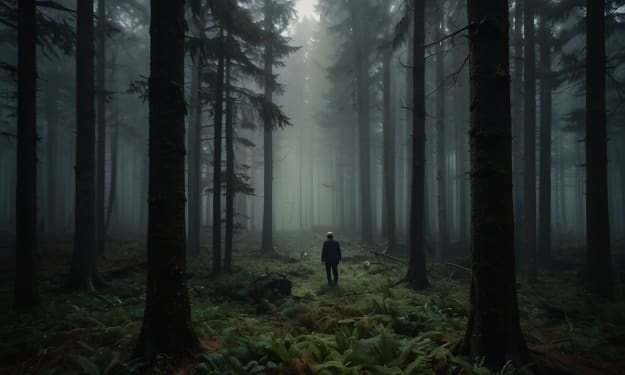The Filmmaker's Guide to Creating Darkness in Horror
Study, Experience, and Analysis

(The watchlist for this article in order to gain the best experience for learning is listed as follows: American Werewolf in London, The Woman in Black, The Conjuring 2, The Nun).
Darkness can be created in many ways in a horror film and it may sound a bit simple, but there are methods that are more commonly used and some that we steer clear of. There are also more difficult methods and then, there's the easy flick of the light switch or sudden power cut. What we're going to concentrate on is the way in which darkness is created in different scenes from different films; along the way we'll learn how and why this is done and what the director is trying to achieve through doing this.
We're first going to simply list the five main methods of creating darkness in a physical sense. Then, we will explore each of these in detail, looking at particular examples and examining still images and frames in order to gain insight and learn the reason of why the filmmaker has chosen this method.
Here are the five main methods:
- Night and Pathetic Fallacy
- Antique Light Source (i.e. candles/ill-lit lamps)
- Dark Colours on Set
- The Olden Vagrant World
- Shadowed Objects
Now, let's have a look at what each of these mean in detail, using examples of how and why they are required to make the film the way it is.
1. Night and Pathetic Fallacy
The most used method of darkness in any horror film is night. It is great for creating the atmosphere for the unknown. There are many reasons why it is effective, including:
- Humans normally sleep at night
- The night is dark and therefore, vision is obstructed
- Dangerous animals are commonly associated with the dark and nighttime
- Mythical creature are normally associated with the full moon
And the list goes on.
Pathetic Fallacy refers to the exterior of the film (the exterior ground such as; buildings, the weather, the atmosphere etc.) having an effect on how the film "feels" in terms of mood. This can also be achieved by music and dialogue but is far more effective if achieved by appearance and it is more stable in a horror film in order to create your desired atmosphere.
Let's look at our example still:
'An American Werewolf in London'

American Werewolf in London Still
Now, we have two things about the night and pathetic fallacy that build up the tension towards the climax of the character on the right morphing into the mythical werewolf creature. (Some may be familiar with the music video that took inspiration from this film, Michael Jackson's Thriller that also had the same frame in a similar situation).
First of all, I want you to concentrate on the image behind the characters. What is making it work?
- The fog to create uncertainty
- The night atmosphere to obstruct vision, giving us an unclear image of what might happen, but also highlighting our characters
- The fact that the image of the grass seems to morph with the fog and fade into a complete darkness. This creates the idea of nothingness and therefore, makes the audience feel uneasy about where the characters are.
The second thing I want you to do is put the characters back into this setting. Now, how is the darkness foreshadowing what's going to happen now that the characters have re-entered this frame?
- The colour of the jackets display an obvious foreshadowing by having the character who is going to become a werewolf stand out in brighter colours. The red symbolising death.
- The character who is the victim of the attack therefore is faded in with the uncertain atmosphere of darkness to represent his uncertain fate.
As we have already said in a previous paragraph:
"Mythical creature are normally associated with the full moon."
We have a very uncertain and foggy night atmosphere, heightened with the way in which the characters are designed in this particular frame of the film and looking at the fade of background into black, we can safely say that this may be a very dangerous mythical creature because of the situation the frame is in.
2. Antique Light Source (i.e. candles/ill-lit lamps)
Antique light sources are normally used in films that are set within an old, or abandoned setting. This creates the effect of the uncertainty in the character's sight and solidifies with the audience, the obstructed vision. Obviously, there's a lot to be said about symbolism in the use of candles and ill-lit oil lamps can reflect that murky 19th century atmosphere one would hope to achieve when filming something like Frankenstein or Dr. Jekyll and Mr. Hyde.
- The setting is pre-20th Century
- The setting does not have its own light source
- The character carries the light source in order to have a better view of the setting (this can include torches etc.)
Now that we have these reasons, we can have situations to match them. There are three main situations of this antique light source:
- The antique light source is part of the setting as the character enters and therefore, is still and not removed from positioning: This can create the effect of lighting on parts of the setting as the character moves around it; thus we find a better sense of symbolism but maybe an obstructed view of more important parts of the set
- The antique light source is carried in by the character: This can create the effect of the character and wherever they are standing being constantly lit, leaving the rest of the setting in darkness. This is more effective when using tracking shots behind or over the shoulder of your character, maybe even a POV shot. It is probably less effective if your character walks into frame and you may want to consider what the audience does and does not see in that case.
- The antique light source is a part of the setting as the character walks in, but is removed by the character and carried through the setting: This is effective in a more abandoned setting and can suggest to your audience by minute detail that someone had been there before. This would work well especially if the light source is damaged; it offers the question of what happened to them. The effect this can have on the lighting of the set and how darkness is created is via the character having to physically create the momentary and ill-lit atmosphere, therefore noting that they are probably in fear of what could be in the dark. Thus, tension increases as this is reflected back on to the audience.
Let's have a look at how this is used in our example:
'The Woman in Black'

The Woman in Black Still
Now, we can see where the main light source in and where, according to that light source, where the other light sources could be as the character, Arthur Kipps, moves along the hallway. The hallways are lit on the sides by large candles, creating light directly in front of and behind the character, therefore making the the rest of the hall look dark and obstructing its view.
Notice how the sides of Arthur Kipps are kept in almost complete darkness, this is not only caused by their colour but because of the ill-lit atmosphere. The candles cannot light that far and therefore, keep the small bursts of light on important things in the setting that will come into use later. This includes the nursery room door.
Now, let's have a look what happens when we change the function of the candle light source in the same film and a similar scene:
New Function:

The Woman in Black Still
Notice how this now completely changes the colours, the setting and what the audience sees. It is, perhaps, more uneasy but the only thing that has happened is that our character is a little further down the hallway and he is now holding the light source in front of him and at eye level.
Look at what is in focus here. We're made to notice the cobwebs on the candlestick and the reddish walls, which means the walls were never black as they're seen in the previous shot. It is just a trick of the light. Also notice how the shadows are created, showing the audience where the candles are and how they're placed. It makes the atmosphere look darker than it actually is, perhaps instead of lighting the set which it is supposed to do for the character.
Now, if we were to remove the character from this image but keep the light source exactly where it is, we can see that the background is completely dark. There is no light source in that background. The only thing we are suggested to see is the open room behind the character, which has its own ill-lit light source as it doesn't make itself fully known in the darkness of the hallway.
It is very hard to see, but the fact that it is there means that there is something tense about to happen. The tension is increased by not only the shadows, but also the random placings of ill-lit light sources in the set and most importantly, behind and away from the character who requires them.
Therefore, we can see the two different functions of the same light source having a completely different effect and used in two entirely different ways to contrast light and dark.
3. Dark Colours on Set
Dark colours are perhaps some of the most overused characteristics of a horror film. When making a horror film, you want certain things to be dark yes, but not everything as the film will end up looking clogged with atmosphere and there'll be not enough substance and reality for the audience to relate to.
- How do the dark colours enhance the atmosphere?
- How do the dark colours add to the audience experience and understanding?
- How do the dark colours function in different ways?
Let's have a look at our example then and try to answer each of these questions:
The Conjuring 2

The Conjuring 2 Still
Here, we see the character of Ed Warren painting the demon nun, Valak—and of course, a nun wear dark colours so there is our focal point. Everything around this painting, or in its immediate perimeter is therefore darkened and the only light source lights our characters and not so much the painting. It is an interesting technique.
Let's move on to answering our main questions:
How do the dark colours enhance the atmosphere?
It is obvious that the painting of a black-dressed nun with black eyes and a greyish skin tone would make the audience uneasy and therefore, increase the atmosphere of darkness through not only the physical aspect but also the suggestive one (the juxtaposition of nuns and demons is really worth the investigation if you get time).
But let's take the painting out of the setting. Now we have certain parts of the frame that look darker than the others. For example, we have the piece of frame directly under Ed Warren's arm which is pitch black and immediately next to the painting. It is not actually pitch black, but in a single frame, it would be assumed. In fact, it's actually dark brown because of the mahogany item that is next to it. This, plus the light source, creates a shadow on to the frame and therefore, makes everything else look a lot darker than it actually is.
How do the dark colours add to the audience experience and understanding?
Obviously, the painting is the focal point and therefore, through darkness and suggestion there would be audience understanding in the fact that they should probably fear this demonic nun. But, the fact that this painting, for some reason, is done in such an ill-lit room enhances the understanding of the painting by making it look much darker than it actually is. If you have watched the full film, you will notice that the painting again stands in complete darkness so that not even the edges of the canvas can be seen. The painting is made to look dark because of suggestion and thus, this makes the audience understand exactly how terrified they should be of Valak, the demonic nun.
How do the dark colours function in different ways?
Now, we have many different functions for darkness and colour within this frame:
- The dark colours enhance the suggestion of what should be feared by the audience
- The dark parts of the room make vision obstructed but also trick the audience into believing that the room is ill-lit when it's actually shadowed by dark browns and blacks
- The colours painted on to a woman who is supposed to be a nun are suggestive by juxtaposition
Let's have a look at a different frame from the same film and explore exactly what the answer to these questions could be:
Frame 2

The Conjuring 2 Still
This, I believe, is the best still in the whole film. It is so cleverly coloured and designed that we must step back and appreciate what we've been given. The camera angles, light source and colours all add to the experience of the frame and even the way things are placed makes for an incredible set. But, here, we're looking at colours and how and why they're used, so let's get on with answering the questions:
How do the dark colours enhance the atmosphere?
As you can probably see, everything is rather dark in this frame. But, if we look closer, we can just about see the back wall. Now, let's just remove Valak from the scene for one moment. The dark colours on there own and without Valak could create a great atmosphere. It is well documented that darkness makes a space seem bigger than it actually is and, in this case, it makes the hallway look as long as it can.
We have these dark shadowy walls that enhance the atmosphere by their suggested length and then, the juxtaposing colour of the white frame around the end of the hallway and the bannisters on the bottom. This creates very little light, but is effective if a dark object was to be placed dead centre. In comes Valak and therefore, we have a good creation of light and dark using very simple colouring.
How do the dark colours add to the audience experience and understanding?
The audience already understands that they should fear Valak, but the dark colours add to this understanding. The darkness of the corridor is only lightened by the bits of white colouring around the edges and thus, we can determine distance. The audience understands that the corridor is long and thin, therefore, creating the length of space but then creating a very claustrophobic space in which this terrifying character inhabits for the frame.
The best part about this frame is that this character entirely dressed in black, stands completely still and therefore, the audience understands that this character does not move in the same space as a normal human being. Humans don't naturally stand completely still for no reason, and so, the fact that this demonic nun is dressed entirely in black adds to the understanding of possible evil and possible inhuman/inhumane characteristics.
Let's now appreciate the fact that only one side of her is seen completely. The left side of Valak (her left, not yours) is the one that is seen entirely by the audience and therefore, creates the image of mystery. By leaving half of her in the grey/black atmosphere and half of her is lit, showing her alabaster-white face, the filmmaker has successfully created a character that is understood as inhuman, mysterious and possibly harmful in a space that is coloured by claustrophobia.
How do the dark colours function in different ways?
- Create space and length
- Show humanity and inhumanity
- Create light and dark without the requirement for a major light source
4. The Olden Vagrant World
What I mean by this is using the colours and items of a set that would be a good setting for a rural/vagrant pre-20th century film. This can be achieved by incorporating various items in order to darken the set. For example; black crockery or even the dark dress code. Not only can you give clues as to where the film takes place, but you can also use the vagrant world in order to make your set more terrifying via the set being a remote and solitary location.
Let's have a look at our example:
'The Blair Witch Project'

The Blair Witch Project Still
Now, there may not be much in this scene to go off, but it does suggest time and place through the creation of darkness. The first and foremost focal point of the frame is the stairs. The state of them and setting of the house itself link together these ideas of the olden world and vagrancy. This means that the characters, because of the location and the dangerous state of the property, could be in danger of being harmed, if not by a dangerous entity then probably by something breaking or falling on them.
The biggest suggestion of the age of the house is the hole on the opposite wall. It reveals the wooden stature made to make the house, but also no insulation—meaning it's probably quite old. The holes in the walls do another thing; they create a set of seemingly random black voids of nothingness in the house, adding to the darkness.
The black voids are given a better view by the way in which the camera tracks around the house, but also by the greyscale tone of the scene. This has a massive impact on the way we understand what's going on.
The first thing we understand is that the house is abandoned and probably very old due to the various components in the previous paragraphs.
The second thing we notice, as this is a found-footage film, is that the camera is probably faulty in some way as the rest of the film is shot in colour. This greyscale switch is suggestive of danger and enhance the atmosphere of the "olden" house.
The third thing we notice is the way the camera is held and what it reveals about the age of the house. There aren't any windows; the shot deliberately shows us this in the frame as the black void in the background is a window in which nothing exists. This heightens the feeling of vagrancy because of the lack of anything within the space, giving life and depth to the remote location.
5. Shadowed Objects
We've already spoken about objects being obstructed by light, but let's have a look in more depth at the effect of shadowing certain things in a particular scene by design. Of course, there's the more effective shadows which obstruct the vision of what's actually happening in order to create that momentary uncertainty in the frame, but then there's another type of shadowing which is there for the effect of space and depth (see: The Conjuring 2 second frame)
Let's have a look at an example of this:
'The Nun'

The Nun Still
The shadows in this scene are incredible and the way in which the shadowed objects and character creates the atmosphere of the scene is very effective for suggestions of what is to come.
Let's first look at where exactly the only light source is and what it's lighting up. It's in the top left hand corner of the malevolent focal character (her left) and therefore, creates a hazy shadowed effect upon them; the air of mystery has been put in place.
The focus is on a character with a possible light source on their face sitting down, this levelling allows the audience to see the full effect of the shadow on the character in the background. Again, this is highly effective if you were to create a scene in which you had two entirely different character focal points.
Finally, the colour inside the space in which Valak stands is slightly lighter than the lighting of the room and therefore allows more of this shadowed effect to be see and thus, heightens the level of darkness inside the room with the other character. The audience understands this as a momentary danger.
What a beautiful frame, am I right?
Conclusions
Thank you for reading this article. I hope you enjoy creating darkness in many different ways and finding your own methods and shots in order to do so. The way in which darkness is used in horror films is always a point of interest to the viewer as it facilitates our understanding of the fear we feel towards the film. Remember that your darkness should be dependent on your shot and frame, placing and characters so, good luck on your next project!
About the Creator
Annie Kapur
200K+ Reads on Vocal.
English Lecturer
🎓Literature & Writing (B.A)
🎓Film & Writing (M.A)
🎓Secondary English Education (PgDipEd) (QTS)
📍Birmingham, UK






Comments
There are no comments for this story
Be the first to respond and start the conversation.